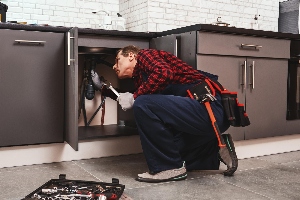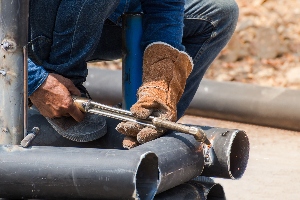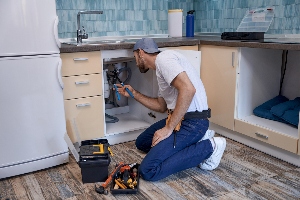Summer is the perfect time to tackle plumbing upgrades that can improve your home's efficiency and value. With warmer weather and longer days, May through August provides ideal conditions for completing these projects.
Upgrading to low-flow fixtures, installing a tankless water heater, or replacing old pipes with modern materials like PEX or copper can significantly reduce your water usage and lower your utility bills.
We often find that kitchen upgrades offer the best return on investment for homeowners. Modern touchless or pull-down faucets not only add convenience but also help conserve water.
Another smart summer upgrade is installing a recirculation system that keeps hot water ready in your pipes, eliminating the wait time and water waste when turning on fixtures.
These improvements don't just make your daily life more convenient – they're investments in your home's future value.
While some projects may require professional installation, summer's flexible scheduling makes it easier to book qualified plumbers who can complete the work efficiently and correctly.
In this article, we’ll explore smart plumbing improvements that boost your home’s efficiency, reduce water and energy waste, and increase long-term reliability.
Here's what you need to know:
- Plumbing upgrades every homeowner should consider this summer
- Prevent leaks and reduce water waste with smart plumbing upgrades
- Modern plumbing upgrades for efficient kitchens and bathrooms
- Why summer plumbing upgrades are worth the investment
- Plumbing upgrade incentives and rebate programs
From modern fixtures and pressure solutions to eco-friendly systems that lower your utility bills, these upgrades deliver both performance and peace of mind.
Plumbing upgrades every homeowner should consider this summer
Summer is the perfect time to improve your plumbing system. These key upgrades will enhance your home's water efficiency, prevent potential problems, and save you money on utility bills.
Replace old plumbing pipes with modern materials like PEX and copper
Old pipes can cause serious problems, especially during summer when water usage increases. Homes built before the 1990s may have galvanized steel or polybutylene pipes that are prone to corrosion and leaks.
We recommend replacing these with copper, PEX, or CPVC pipes. These modern materials are more durable and less likely to develop leaks or burst during temperature fluctuations.
PEX piping is particularly beneficial as it:
- Resists freezing and thawing cycles
- Installs quickly with fewer connections
- Costs 20-40% less than copper
The replacement process typically takes 2-5 days depending on your home's size. While this represents a significant investment ($2,000-$15,000), it prevents costly water damage and improves water quality.
Eco-friendly plumbing upgrades: Low-flow fixtures that save water
Replacing old fixtures with water-efficient models is one of the most cost-effective plumbing upgrades. Modern low-flow fixtures can reduce water consumption by 30-50% without sacrificing performance.
Key fixtures to upgrade include:
- Toilets: Switch to dual-flush or low-flow models (1.28 gallons per flush)
- Showerheads: Install WaterSense-labeled models (1.8 GPM or less)
- Faucets: Replace with aerator-equipped versions
These upgrades typically pay for themselves within 1-2 years through water savings. For a family of four, efficient fixtures can save approximately 30,000 gallons annually.
Smart leak detection systems are also worth considering. These devices monitor your water usage patterns and alert you to potential leaks before they cause damage.
Plumbing upgrades to improve water pressure and flow
Low water pressure is particularly frustrating during summer when multiple water sources are often used simultaneously. Several upgrades can address this common problem.
Start by installing a pressure regulator if you don't already have one. This device ensures consistent pressure throughout your home, typically between 45-60 PSI.
Consider these additional improvements:
- Replace corroded pipes that restrict water flow
- Install a pressure booster pump for homes with chronically low pressure
- Upgrade your main water line if it's undersized for your needs
For multi-story homes, a pressure-boosting system can ensure strong flow on upper floors. These systems cost $700-$2,000 but make a significant difference in shower performance and appliance efficiency.
Regular maintenance of pressure-related components helps prevent both low pressure and damaging high-pressure situations.
Prevent leaks and reduce water waste with smart plumbing upgrades
Water leaks can waste thousands of gallons annually and cause expensive damage to your home. Taking proactive steps now can help you save money and conserve water throughout the summer months.
Install leak detection devices
Leak detection devices are essential tools in modern plumbing systems. These devices can alert you to leaks before they cause significant damage. Simple leak detectors can be placed near water heaters, washing machines, and under sinks to detect moisture.
More advanced systems connect to your main water line and can automatically shut off water if they detect unusual flow patterns. Some models can even send alerts to your smartphone when they detect a leak.
We recommend installing detectors in high-risk areas like bathrooms, laundry rooms, and basements. The initial investment in these devices typically ranges from $50-$200 but can save thousands in potential water damage repairs.
For older homes, leak detection systems are particularly valuable as aging pipes are more prone to developing problems.
Find and seal common plumbing leak points in your home
Inspecting and sealing common leak points should be part of your summer plumbing maintenance. Start by checking visible pipe connections under sinks and behind toilets for moisture or corrosion.
Replace worn washers and gaskets in faucets and showerheads. These small parts often cause drips that waste water and increase bills.
Don't forget to examine outdoor spigots and irrigation systems. These components face harsh weather conditions and often develop leaks.
Use pipe tape or thread sealant on threaded connections that show signs of leaking. For minor cracks, pipe repair clamps provide a temporary solution until professional help arrives.
Regularly check toilet tanks by adding food coloring to the water. If color appears in the bowl without flushing, you have a leak that needs fixing.
Smart water monitoring for leak detection and conservation
Smart water monitoring systems represent the cutting edge of leak prevention technology. These devices track your water usage patterns and can detect abnormalities that indicate leaks.
Most smart monitors connect to your home's WiFi network and provide real-time data through smartphone apps. They can show exactly how much water different fixtures use and help identify wasteful habits.
Benefits of smart water monitors:
- Detect hidden leaks in walls or underground
- Track water usage by time and fixture
- Set conservation goals and receive progress updates
- Receive alerts when unusual water flow is detected
Some advanced systems can differentiate between normal water usage and leaks based on flow patterns. This technology helps prevent false alarms while still catching actual problems.
We've found that households using smart water monitors typically reduce their water consumption by 15-20%, leading to significant savings on utility bills.
Modern plumbing upgrades for efficient kitchens and bathrooms
The kitchen and bathroom offer excellent opportunities for plumbing upgrades that can dramatically reduce water usage while improving functionality. Smart investments in these areas provide immediate benefits and long-term savings.
Energy-efficient dishwasher upgrades to save water
Modern dishwashers use significantly less water than older models. ENERGY STAR certified dishwashers use as little as 3 gallons per cycle, compared to older models that might use 10-15 gallons.
When shopping for a new dishwasher, look for models with soil sensors that adjust cycle length based on how dirty your dishes are. This feature prevents unnecessary water and energy use.
Some advanced models offer half-load options for when you don't have a full dishwasher, saving even more water.
Installation typically requires connecting three things: the water supply, drain line, and electrical power. We recommend hiring a professional plumber to ensure proper connections and prevent leaks.
The cost for a new efficient dishwasher typically ranges from $400-$1200, but the water and energy savings often pay for themselves within a few years.
Install low-flow toilets
Toilets account for nearly 30% of an average home's indoor water use. Replacing older models with low-flow toilets can reduce water consumption dramatically.
Standard toilets from the 1980s use 3.5 to 7 gallons per flush. Modern low-flow toilets use just 1.28 gallons or less while maintaining excellent flushing power.
Look for WaterSense labeled toilets, which are certified to meet EPA standards for both performance and efficiency. Dual-flush models offer different flush volumes for liquid and solid waste.
Installation costs typically range from $150-$500 plus the toilet itself.The average family can save nearly 13,000 gallons of water annually with this single upgrade.
According to the EPA, WaterSense-labeled toilets offer these savings by using just 1.28 gallons or less per flush, compared to the 3.5–7 gallons used by older models.
For maximum savings, consider models with pressure-assisted flushing technology, which uses compressed air to enhance flushing power with minimal water.
Replace outdated faucets and showerheads with water-saving models
Replacing outdated showerheads and faucets is one of the easiest and most cost-effective plumbing upgrades available. Modern low-flow fixtures maintain strong pressure while using less water.
WaterSense labeled showerheads use no more than 2.0 gallons per minute, compared to older models that use 5-8 gallons per minute. Many newer designs incorporate air into the water stream to maintain pressure.
For faucets, look for models with aerators that mix air with water. This creates the feeling of higher water pressure while actually using less water.
Touchless faucets prevent unnecessary water flow and reduce the spread of germs. They're particularly useful in households with children.
Most faucet and showerhead replacements are simple DIY projects requiring basic tools. The fixtures themselves typically cost between $20-$200, with luxury models available at higher price points.
Why summer plumbing upgrades are worth the investment
Investing in plumbing upgrades during summer months delivers significant advantages that extend well beyond the initial installation. These improvements can transform your home's efficiency while providing financial benefits for years to come.
How plumbing upgrades help reduce maintenance and utility costs
Summer plumbing upgrades can dramatically cut your long-term maintenance expenses. Modern plumbing fixtures require less frequent repairs compared to older models, saving you money on emergency calls.
Lower utility bills are a major benefit of energy-efficient upgrades. Low-flow faucets and showerheads can reduce water usage by up to 30%, directly impacting your monthly bills. Modern toilets use less than half the water of older models.
New piping materials like PEX or copper resist corrosion and leaks better than aging galvanized pipes. This means fewer repairs and water damage incidents over time.
Smart leak detection systems can alert you to problems before they cause expensive damage. These devices can detect even tiny leaks that might otherwise go unnoticed for months.
Increase your home’s value with modern plumbing upgrades
Updated plumbing systems significantly boost your property's market appeal. Potential buyers recognize the value of modern plumbing and are often willing to pay more for homes with recent upgrades.
Key value-adding upgrades include:
- Energy-efficient water heaters
- Modern fixture designs
- Updated pipe materials
- Smart water management systems
These improvements signal to buyers that the home has been well-maintained. Real estate professionals report that updated bathrooms and kitchens with modern plumbing can return 70-85% of their cost at resale.
Water-saving fixtures also appeal to environmentally conscious buyers. As water conservation becomes increasingly important, homes with efficient plumbing systems stand out in competitive markets.
Smart plumbing technology integration represents the future of home systems. These innovations not only impress potential buyers but demonstrate your property is equipped for modern living.
Plumbing upgrade incentives and rebate programs
Upgrading your plumbing system isn’t just good for your water bill—it can also come with financial support. Many local utilities, state agencies, and even federal programs offer incentives for homeowners who invest in water-saving and energy-efficient plumbing improvements.
Types of available rebates and credits
Plumbing rebates are most commonly available for the following upgrades:
- WaterSense-labeled fixtures: Many municipalities offer cash rebates ($25–$100 per unit) for toilets, faucets, and showerheads that meet EPA WaterSense standards.
- High-efficiency water heaters: State-level energy departments often offer tax credits or rebates for tankless or solar water heaters. These may cover up to 30% of the installation cost in combination with federal incentives.
- Leak detection systems: Some utilities offer rebates for installing smart leak monitors that help reduce water waste and prevent damage.
- Greywater and rainwater systems: In some areas, homeowners can receive grants or subsidies for integrating rainwater capture or greywater reuse systems into their plumbing design.
Where to find rebate programs in your area
Start your search here:
- Local water utility website: Many water districts have conservation or rebate pages listing active programs.
- Energy Star Rebate Finder: lets you search for water heater rebates by ZIP code.
- EPA WaterSense Rebate Map: lists fixture-related programs nationwide.
- State energy offices: Many states have seasonal incentives for energy-efficient upgrades, especially for solar systems.
Always read the fine print, some programs require pre-approval or installation by licensed contractors.
How incentives increase ROI for plumbing upgrades
Incentives significantly improve the return on investment (ROI) of your upgrades. A low-flow toilet that costs $300 might end up costing under $200 after rebates, while saving up to 13,000 gallons of water per year. The upfront savings lower the payback period, and the long-term reduction in utility bills adds even more value.
Combined with tax credits for energy-efficient equipment and potential increases in home resale value, these programs make sustainable plumbing upgrades a smart financial move, not just an eco-conscious one.
Conclusion
Plumbing upgrades are more than a seasonal checklist, they’re long-term investments in your home’s performance, safety, and value. Whether you’re replacing old pipes, switching to low-flow fixtures, or installing leak detection systems, each improvement adds efficiency, lowers your utility costs, and protects your home from preventable damage.
These upgrades not only reduce water and energy waste, they also prepare your home for the future. And with modern fixtures and eco-friendly systems more accessible than ever, now is the perfect time to take action.
If you’re ready to upgrade your plumbing this summer, One Call Plumbing offers expert guidance and installation for every type of home improvement. Let’s build a more efficient home, one upgrade at a time.












